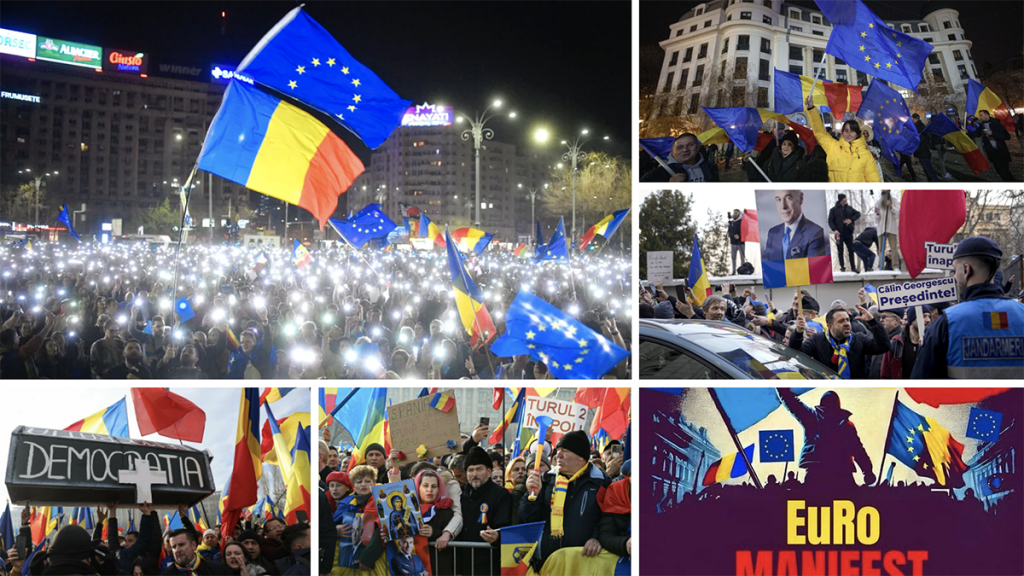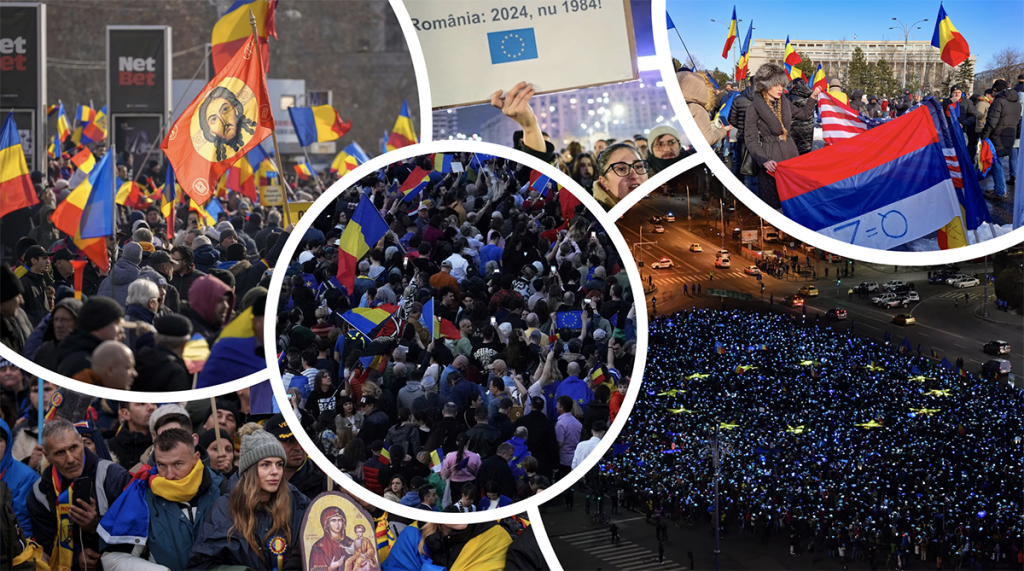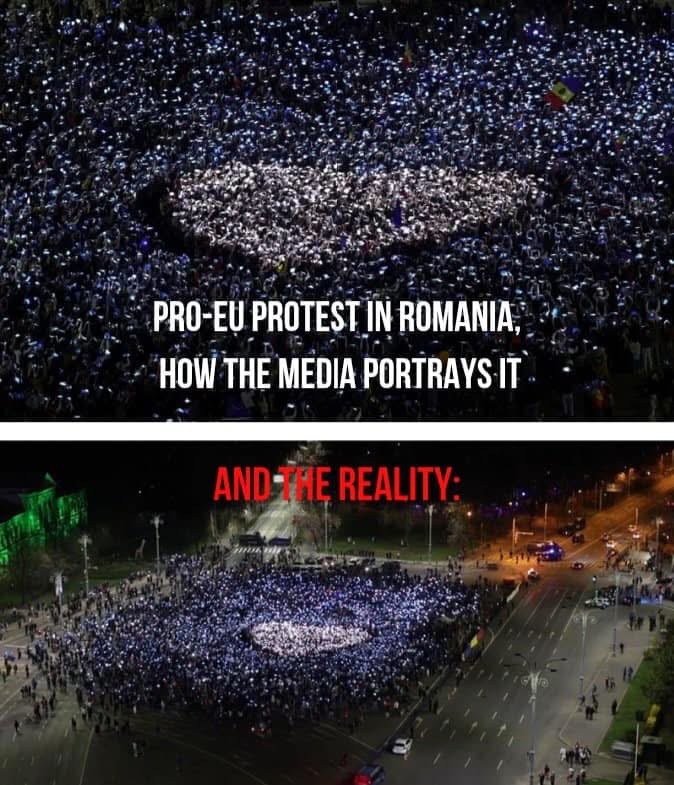A picture may be worth a thousand words, but protest visuals, especially during political upheaval, read like novels. Mimi Mihăilescu shows how visuals aren't just for documentation – they persuade, polarise, and shape public opinion. In Romania, where two protest factions are currently clashing, visuals are on the frontline of political warfare
Protests have always been visually compelling. Iconic footage such as the solitary man defying the tank in Tiananmen Square and images of police brutality during America's Civil Rights Movement have defined political struggles. In the 21st century, the influence of images has only intensified. The Arab Spring protests were fuelled by viral footage, and Black Lives Matter demonstrations gained global attention through social media snapshots. The chaotic, often surreal, imagery of rioting at the US Capitol on 6 January 2021 is seared into public memory.

In Romania, the role of protest visuals is particularly striking. Footage of crowds storming Ceaușescu’s palace, marking the nation’s release from dictatorship, immortalised the 1989 Revolution. More recently, the 2017 anti-corruption protests saw Bucharest’s Victory Square illuminated by hundreds of thousands of citizens holding flashlights aloft to symbolise democratic resistance. Today, Romania is riven by a new ideological divide. Once again, images of protest are at the forefront of national consciousness.
Two competing visions for Romania’s future have materialised in recent demonstrations. One advocates for continued EU integration; the other aligns with the nationalist, sovereigntist rhetoric of Călin Georgescu, who has been barred from running in May's election for having contested the first round by fraudulent means. This ideological divide influences not only Romania's political alignment but touches upon its national identity amid shifting global influences.
The pro-EU movement mobilised several thousand demonstrators who want to continue Romania’s post-communist journey toward European liberal democracy, across cities including Bucharest, Cluj, and Timișoara. These people condemn perceived Russian influence and endorse a Manifesto for Europe backed by more than 40 organisations.
Pro-EU demonstrators – predominantly younger Romanians, urban professionals, and activists – advocate for a Romania deeply embedded in Western institutions. They wave EU and Romanian flags, hold placards advocating for the rule of law, and chant in defence of democratic values. Their protests reinforce the vision of Romania as a modern, cosmopolitan nation, firmly anchored in Western institutions.
Similar pro-European protests have taken place in Hungary, with opposition groups rallying against Viktor Orbán and his government. In Serbia, too, mass movements have denounced perceived democratic backsliding.
Pro-Georgescu protests have drawn demonstrators of a very different persuasion. These people channel nationalist sentiment; they focus on sovereignty and tradition – and they are deeply sceptical of external (EU) control. Georgescu's backers took to the streets with Romanian tricolour flags, US and Russian flags, Orthodox Christian symbols, and slogans rejecting globalism.
Their imagery invokes historical nostalgia, portraying Romania as a nation under siege by Western bureaucratic elites. Unlike their pro-EU counterparts, these demonstrators perceive themselves as resisting foreign encroachment rather than authoritarianism. Tensions escalated into violent clashes. Protesters hurled cobblestones and eggs at Central Election Bureau headquarters and set fire to street furniture, injuring several police officers. Their actions recall the 2021 Capitol riots, during which demonstrators challenged the legitimacy of state institutions.

This division extends beyond the streets into the narratives each side constructs. Pro-EU demonstrators position themselves as defenders of democracy, and cast Georgescu's supporters as reactionary nationalists clinging to outdated notions of sovereignty. Their protests feature diverse crowds, artistic placards, and messages of unity seeking to reaffirm Romania's European trajectory. Their opponents they portray as pawns of Russian disinformation and conspiracy theories.
Conversely, the Georgescu camp views itself as the last line of defence against external manipulation. Their imagery of religious iconography, historical figures, and nationalistic slogans depicts the pro-EU movement as elitist, detached from ordinary Romanians, and blindly submissive. Their protests are designed to provoke the opposition, casting EU-aligned protesters not patriots but traitors, manipulated by NGOs and foreign interests into dismantling Romania’s cultural and political autonomy. Ultimately, the two camps are not merely competing political demonstrations; they represent battles over Romania's future identity.
The protests in Romania are not just battles for the streets but struggles for narrative control. Mainstream media, largely West-leaning, portrays pro-EU demonstrators as defenders of democracy. The pro-Georgescu movement it frames as reactionary and anti-European. Meanwhile, nationalist media and social media influencers depict pro-EU protesters as 'globalist puppets'; detached elites subservient to Brussels. These conflicting portrayals do more than report events; they actively shape public opinion, reinforcing ideological divides, as in the picture below:

Social media takes this war a step further. A single photo, stripped of context, becomes a weapon. A user might frame a peaceful pro-Georgescu march as a dangerous nationalist uprising or dismiss a pro-EU rally as a staged event funded by external actors. Algorithmic biases intensify this spectacle, amplifying content that fuels outrage. Protest visuals are no longer mere documentation; they are the battlefield on which Romania’s political future is contested.
Many people regard protests as a hallmark of democratic engagement. But what happens when both sides demand change in opposite directions? In Romania, the divide isn’t just between protesters and the government but between two competing national visions. Images of these protests, whether they feature EU flags or nationalist banners, highlight this fundamental rift.
If protests merely reinforce ideological bubbles, it weakens their democratic influence. Protests should demand accountability and representation: a nation split into irreconcilable factions, however, risks stagnation. Protest visuals transcend documentation; they become tools of ideological warfare, deepening divisions rather than fostering dialogue.
One thing is clear: both sides want change. Will Romania bridge its divides, or deepen its polarisation? Only time – and the next wave of protest visuals – will tell.